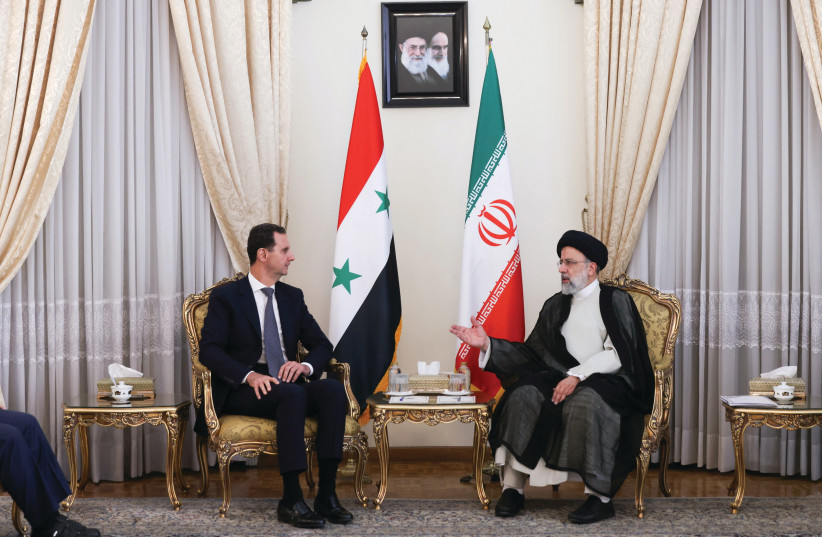Syrian President Bashar Assad visited Oman on Monday for an important trip to the Gulf region, where the Syrian regime has been making new inroads.
During 11 years of the Syrian civil war, the regime was generally isolated and hadn’t hosted foreign government officials. Assad rarely left the country, and his first trip was in 2015 to Moscow, a key backer of his regime.
Damascus has also hosted delegations from Iran and Russia. Last March, Assad visited the UAE, his first trip to an Arab state since the war began. He then visited Iran in May. The Oman trip, therefore, is part of this trend and marks a turning point. The question is, how might this reshape the region?
Syria suffered from the same earthquake as Turkey last month. Some countries captured the opportunity to send aid to Damascus.
The West has generally kept Syria under sanctions, while Russia intervened in 2015 to back the Syrian regime. Turkey has as well, invading parts of the north – ostensibly backing Syrian opposition rebels, but in reality, targeting the US-backed Syrian Democratic Forces (SDF), which controls eastern Syria, where the US holds a few hundred troops.

Iran, meanwhile, backs militias and proxies, including influencing operations in a swath of territory from Albukamal to the Golan and Homs. Syria is a divided country.
Some Arab states have wished for Syria to return the position it was in before the war. This would mean returning to the Arab-state framework.
The Assad regime has been around for decades and was always close with Russia. But the regime also had key ties with the West and, from time to time, would seek to portray itself as moderate and open to working with the West.
Assad's terrorist connections
The regime invaded Lebanon in the 1970s, but it was forced to leave in 2005 after the assassination of former Lebanese prime minister Rafic Hariri. It was close to Iran and Hezbollah and also hosted Palestinian terrorist groups, such as Hamas and Islamic Jihad. Hamas members left Syria in 2012 during the war, but they renewed relations last year. The Hamas members traveled to Qatar and were hosted in Turkey, which are both close with the Muslim Brotherhood.
Before the war, Syria was a key part of the Arab world, having key connections with Iran and Russia, as well as decent relations with Turkey; Ankara even sought to mediate between Israel and Syria in the early 2000s.
Then things changed. Ankara’s “zero problems with our neighbors” policy changed. And Syria chose to fight against its rebels rather than leave office, as Egypt’s Mubarak regime did during the Arab Spring. The brutal war changed the region. The Muslim Brotherhood, ascendant in the 1990s and 2000s, lost out by 2014, and in the Gulf, it was largely banned, except in Qatar.
As the regime solidified itself in 2018, some Arab countries thought it would now be appropriate to bring it back into the Arab world’s diplomatic fold.
Egypt reached out. Jordan, which hosted hundreds of thousands of Syrian refugees and played a role in the Western backing of rebels in the South, rekindled ties, officially speaking to Assad in October 2021. Iraq, because it has good ties with Iran, is also close to Damascus.
Syria’s relations are now growing rapidly. UAE Foreign Minister Sheikh Abdullah Bin Zayed Al Nahyan visited Damascus in January, while Egyptian President Abdel Fattah al-Sisi called Assad after the earthquake. Iraq’s Popular Mobilization Forces commander Faleh al-Fayyad visited Damascus last week and met with Assad, according to Syria’s North Press Agency.
The UAE and Turkey are now both sending important aid to Syria. “The Arab world has come around to this realization, and the UAE is characteristically out front,” Al-Monitor news site recently reported. “Assad’s visit to Dubai last year turned heads, but it’s the new reality: Assad is staying, Syria is suffering, and there needs to be an Arab approach to counter Russian and Iranian influence.”
Oman has always had a neutral policy in the region. In 2018, it hosted Prime Minister Benjamin Netanyahu, an important visit that foreshadowed the Abraham Accords. But Oman has appeared to sour a bit since then. Sultan Qaboos, the region’s longest-serving ruler, died at the age of 79 in 2020, outlasting many others.
Today it is Assad visiting Oman. “The two leaders discussed regional issues and bilateral ties before holding a ‘private meeting,’ the statement said without elaborating,” France 24 reported. “Unlike other Arab Gulf states, Oman never severed diplomatic ties with Damascus. In Muscat, Assad praised Oman’s ‘balanced policies’ over the years, the Syrian presidency said in a statement.”
This shows how well Syria is making inroads, in addition to its outreach to Turkey via Moscow, which is interested in reconciliation between the two.
Syria is also interested in brokering energy deals for electricity and resources from Egypt via Jordan to Syria and Lebanon. What’s more, Egypt has been holding important meetings with its backers in the UAE, Saudi Arabia and also with Jordan and Iraq.
It’s entirely plausible that a new state system is emerging in the Middle East – a return to some stability after the chaos from the Arab Spring, the era of the civil wars in Libya and Yemen and extremist terrorist groups.
A big question will be whether the Syrian regime can reduce its dependence on Iran and whether Iran’s entrenchment will lessen in Syria. Iran uses Syria to threaten Israel, for instance, and to move weapons to Hezbollah. Another question is whether Turkey will launch a new operation in eastern Syria against the US-backed SDF or be willing to compromise on Idlib and Afrin.
Syria now knows that China and Moscow won’t help rebuild the country fast enough; it needs backing from the Gulf. What remains unclear is whether its usefulness to Iran’s “axis of resistance” will shift. For backers of the SDF, the outreach to the Gulf is not a surprise – they believe the Gulf is part of the authoritarian trend.